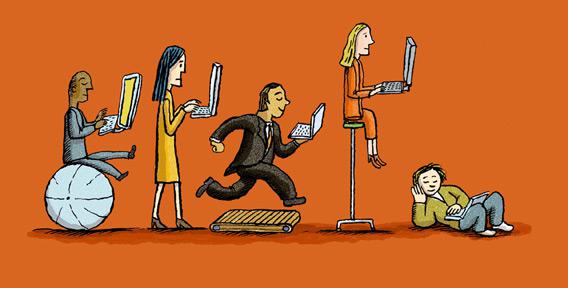In a paper released this week in the journal BMJ Open, scientists at the Pennington Biomedical Researcher Center in Louisiana reported that sitting less than three hours a day could add about two years to a person’s life. Peter Katzmarzyk and his colleagues also reviewed television viewing habits and found that watching less than two hours a day is associated with an increase in life expectancy of 1.38 years. This sounds like bad news for anyone with a cubicle job or a predilection for marathons of Mad Men. Katzmarzyk told the Wall Street Journal that office workers should “try to stand as much as [they] can” in situations such as phone calls and meetings. Can simply standing really counteract the negative health effects of our chair-bound lives?
To some extent, yes. Katzmarzyk’s paper builds on a growing body of evidence that a sedentary job visits a host of perils upon the body. One notable effect is a decrease in the production and circulation of lipoprotein lipase, a molecule that helps determine how fats are processed. Active muscle tissues are partly responsible for producing lipoprotein lipase as well as for the general burning of calories; a variety of muscle groups that are engaged when you’re standing become inactive once you sit down. Office workers can partly counteract this effect by standing up and moving around every 20 minutes or so, a practice that can help maintain a higher metabolism and regular production of lipoprotein lipase. Compartmentalizing exercise into a single period of the day is not enough to combat a lull during the rest of the day, though doctors note that both regular exercise and the occasional walk to the water cooler are necessary.
Some workers have taken these findings to mean that traditional chairs should be abandoned in favor of standing desks—but all that time on your feet carries its own potential health problems. Long periods of standing certainly wear on our ankles and knees. Studies have also shown that standing while pregnant is associated with smaller infant head size. Standing can increase the risk of varicose veins and carotid atherosclerosis (a narrowing of the arteries in the neck). Additionally, ergonomics experts argue that working while standing impedes fine motor skills and exposes keyboard users to a heightened risk of carpal tunnel syndrome due to improper posture and the propensity to lean on the desk (PDF).
Got a question about today’s news? Ask the Explainer.
Explainer thanks Alan Hedge and the Cornell University Ergonomics Department.
Video Explainer: Why is the NRA So Powerful?
This video was produced from an original Explainer by Brian Palmer.
Want more questions answered? You can now watch video Explainers at Slate’s News Channel on YouTube.
